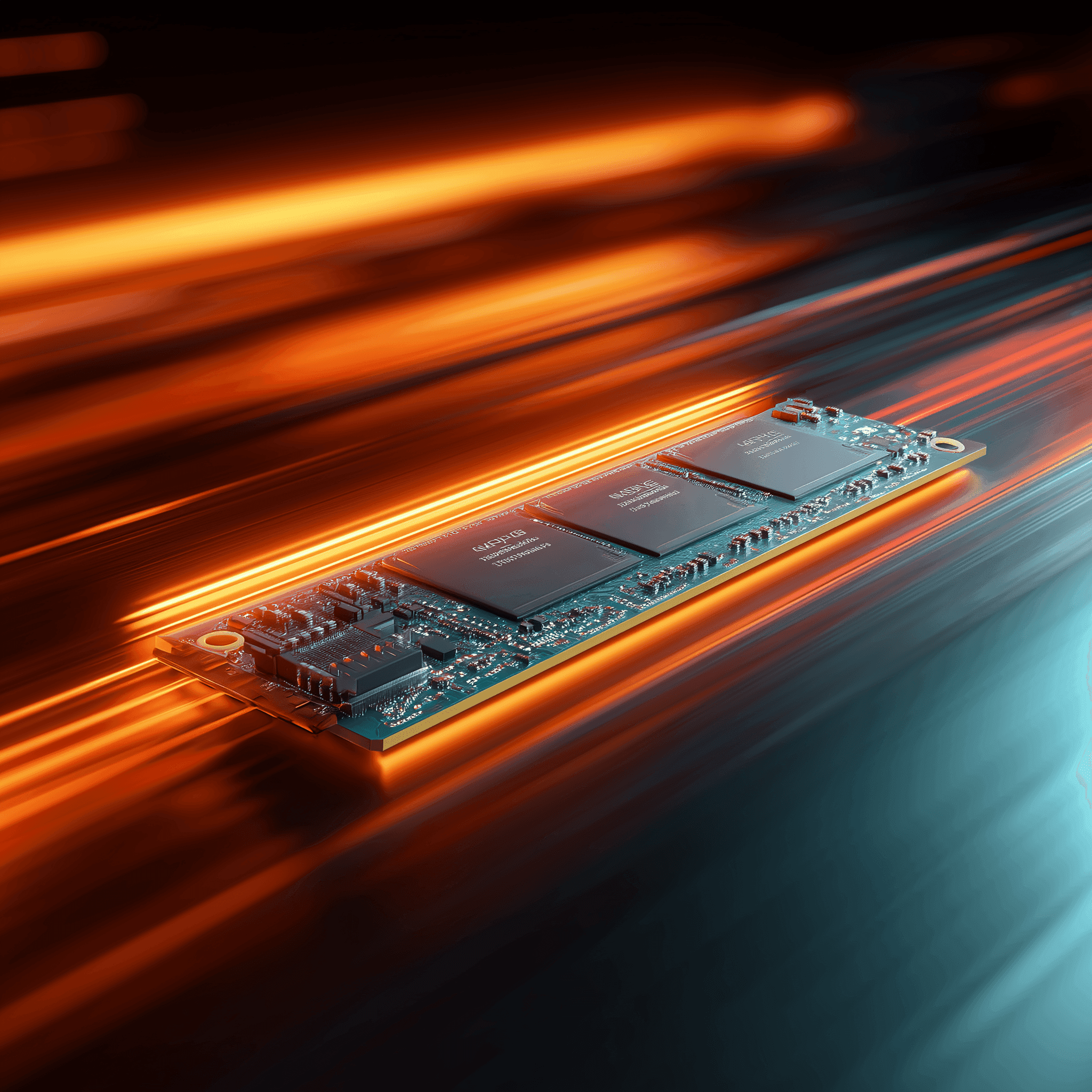NEW! EPYC + NVMe based VPS
10 min read - October 10, 2025

Explore how the latest NVMe drives with over 100Gbps throughput can transform your business operations through enhanced speed and efficiency.
Want faster, smarter storage for your business? The latest NVMe drives now deliver over 100Gbps throughput, solving data bottlenecks and enabling smoother operations. These drives combine PCIe 5.0 advancements with updated NVMe protocols to handle high-speed tasks like AI, analytics, and virtualization. Here's what you need to know:
Whether you're upgrading servers or handling massive data streams, these drives deliver the speed and efficiency your business needs to stay ahead.
Reaching speeds of 100Gbps or more didn’t happen by chance - it’s the result of multiple advancements coming together, much like upgrading from a single-lane road to a multi-lane highway. Let’s break down the key technologies behind this leap.
At the heart of NVMe’s speed lies PCIe (Peripheral Component Interconnect Express) technology, which has consistently doubled bandwidth with each new generation.
Beyond raw speed, PCIe 5.0 also improves signal integrity and includes advanced error correction, ensuring these speeds are both fast and reliable in real-world use. These advancements set the stage for the NVMe protocol to further refine and optimize data movement.
If PCIe is the highway, the NVMe protocol acts as the traffic controller, ensuring data flows efficiently. Recent updates to the NVMe specifications bring features that significantly enhance performance.
These protocol upgrades directly contribute to the jaw-dropping performance figures we’re seeing today.
Modern PCIe 5.0 NVMe drives deliver sequential read speeds exceeding 12,000 MB/s and write speeds of over 11,000 MB/s. That’s more than 96 Gbps for reads and 88 Gbps for writes, and when you consider bidirectional operations, these drives comfortably surpass the 100Gbps benchmark.
Random performance has also taken a massive leap forward. High-end drives now achieve over 1.5 million random read IOPS and more than 1.3 million random write IOPS. This is crucial for applications like database management and virtualized environments, where small, random data requests dominate.
Latency improvements are equally impressive. Today’s NVMe drives achieve read latencies under 100 microseconds and write latencies below 20 microseconds, compared to the 500+ microseconds seen with traditional SATA SSDs.
The combination of PCIe 5.0’s bandwidth and NVMe’s refined protocols ensures that these speeds hold steady, even under demanding workloads. Whether it’s handling massive sequential files for video editing or managing thousands of small database transactions, NVMe drives deliver consistent, high-speed performance across the board.
The evolution of NVMe technology is reshaping how businesses handle massive amounts of data. With their incredible speeds, these drives aren't just about faster storage - they're redefining how data-heavy operations function, giving businesses a real edge in competitive industries.
AI and machine learning systems thrive on fast, uninterrupted data access. High-performance NVMe drives eliminate storage bottlenecks, ensuring GPUs can operate at their full potential. For tasks like training neural networks, computer vision, or handling real-time inference, the ultra-low latency of NVMe drives is essential. These drives keep up with the intense demands of modern AI workloads, ensuring smooth and efficient processing.
When it comes to real-time analytics, speed is everything. Industries like high-frequency trading, telecommunications, IoT, and digital advertising rely on NVMe drives to quickly process and analyze massive streams of data. Whether it's managing large data lakes, conducting log analysis, or monitoring security systems, these drives enable near-instant ingestion and correlation of information. This capability also enhances the performance of virtualized environments, making them more efficient and responsive.
Traditional storage often struggles with the demands of virtualized environments, but NVMe drives break through those limitations. They support higher virtual machine densities and improve container performance by speeding up startup times and providing fast access to persistent storage. For development teams, this means quicker iterations and smoother DevOps workflows, ultimately helping businesses stay agile and efficient.
High-performance NVMe drives do more than just speed things up - they enhance infrastructure efficiency and deliver cost savings over time. These benefits go beyond raw performance, directly impacting operational budgets and creating a strong case for adopting this technology.
NVMe drives significantly cut down on latency, making database queries and web applications snappier and more responsive. This translates to a better user experience, which is especially critical in industries like financial trading or e-commerce, where even small delays can have a noticeable impact.
With their ability to handle a much larger volume of input/output operations per second, NVMe drives enable servers to manage more users and transactions simultaneously without slowing down. This scalability ensures smooth performance even during peak activity.
Compared to traditional spinning drives, NVMe technology is far more energy-efficient. These drives consume less power and generate less heat, leading to lower energy bills, reduced cooling needs, and fewer demands on data center infrastructure.
Their durability and advanced management features also mean fewer failures and longer lifespans. This translates to less frequent maintenance, fewer disruptions, and a more reliable system overall.
While NVMe drives come with a higher upfront cost, the long-term savings in power usage, cooling, and maintenance quickly balance the scales. Add to that the faster performance and simplified capacity planning, and the return on investment becomes clear. NVMe technology is not just a performance upgrade - it's a smart financial decision.
Modern NVMe drives have transformed server performance, but proper installation is key to unlocking their full potential. This involves checking server compatibility, managing heat effectively, and ensuring seamless data migration.
Before installing NVMe drives, confirm that your server supports the necessary PCIe generation and that its PCIe slots can handle the demands of NVMe drives. Selecting the right form factor is equally important. Options include:
If you're using multiple NVMe drives, plan your storage pooling strategy early. Software-defined storage can consolidate drives into larger, resilient pools, combining high performance with redundancy. Additionally, ensure your server has enough PCIe lanes to support the performance needs of each drive.
Once compatibility is verified, it's time to focus on thermal management, which is critical for maintaining performance.
NVMe drives can generate significant heat under heavy workloads, which may impact performance. Keeping temperatures within manufacturer-recommended limits is essential for consistent operation.
While many modern NVMe drives include over-temperature protection, a robust cooling setup ensures better performance stability and extends the lifespan of your drives. Once thermal management is in place, focus on data migration and monitoring to optimize your system.
Migrating data from older storage systems to NVMe drives requires a well-thought-out strategy. Take into account your current workload patterns and the capabilities of your new NVMe setup.
After installation, monitoring performance is vital. Use SMART tools to track drive health, including metrics like wear leveling and temperature. Third-party tools can provide deeper insights into IOPS, queue depths, and thermal behavior.
Document baseline metrics like throughput, latency, and temperature to help with troubleshooting and future capacity planning. Regular firmware updates are also crucial - they not only enhance performance but also address security vulnerabilities, all without disrupting operations.
The newest generation of NVMe drives, capable of delivering over 100Gbps throughput, isn't just a simple storage upgrade - it’s a game-changer for handling data-heavy operations. These drives remove performance bottlenecks, paving the way for smoother and more efficient workflows.
Beyond eliminating bottlenecks, the performance enhancements of PCIe Gen5 NVMe drives offer noticeable business advantages. With reduced latency and significantly higher throughput, these drives can supercharge AI and machine learning processes, enabling faster iterations and quicker, more informed decision-making.
Energy efficiency is another standout benefit. Modern NVMe drives consume less power and generate less heat, which translates to lower cooling requirements. Combined with higher-density configurations, these energy savings can significantly reduce long-term costs, maximizing your return on investment.
Scalability is equally important. NVMe drives are built to handle increasing workloads that would typically require multiple traditional storage solutions. This consolidation not only simplifies infrastructure management but also reduces the complexity of provisioning and maintenance. With less time spent on upkeep, IT teams can focus on projects that drive innovation and growth. Plus, this scalability ensures your infrastructure evolves as your business faces new challenges.
Finally, NVMe technology with 100Gbps+ capabilities prepares your storage environment for the future. As data volumes grow and applications demand higher performance, having a fast, scalable storage solution is essential to stay competitive without frequent, costly upgrades.
To figure out if your business is ready to handle NVMe drives with speeds exceeding 100Gbps, start by taking a close look at your current hardware setup. Specifically, check whether your servers are equipped with PCIe Gen4 or Gen5 interfaces - these are crucial for reaching such high levels of performance. Also, make sure your network infrastructure can manage the increased bandwidth to prevent any bottlenecks.
Next, evaluate your server's CPU capabilities and IOPS capacity (input/output operations per second). These two elements play a big role in determining how well your system can take advantage of NVMe technology. If your business depends on resource-heavy applications like AI, machine learning, or real-time data analytics, upgrading to NVMe drives could deliver a noticeable boost in performance, lower latency, and better scalability.
Upgrading to NVMe drives can significantly boost performance, but it’s not without its challenges. One common issue is hardware compatibility. Your servers might need updated PCIe slots or controllers to support the higher bandwidth that modern NVMe drives demand. Without these updates, you won’t be able to take full advantage of their capabilities.
You’ll also need to consider software and firmware updates. These updates are often essential to unlock the full performance potential of NVMe drives, ensuring they operate efficiently within your system.
Another critical aspect is addressing possible bottlenecks in your system architecture. For instance, PCIe bus oversubscription can limit the performance gains you’d expect from NVMe drives. To get the most out of these high-speed drives, especially for data-heavy tasks like AI, machine learning, and real-time analytics, it’s vital to plan ahead and optimize your infrastructure accordingly.
NVMe drives are a game-changer for energy efficiency in data centers. They consume less power and produce less heat, which means cooling systems don’t have to work as hard. Thanks to modern features like intelligent low-power states, these drives can slash energy use by as much as 20%, translating into substantial cost savings over time.
What’s more, NVMe drives are built to deliver more performance per watt than traditional storage options. This makes them ideal for managing large-scale data operations while keeping operational expenses in check. Plus, they contribute to a smaller carbon footprint per terabyte of storage, offering a greener solution for data centers.

Explore the best monitoring tools for dedicated servers and VPS in 2025, focusing on AI, automation, and real-time analytics.
12 min read - November 28, 2025

Flexible options
Global reach
Instant deployment
Flexible options
Global reach
Instant deployment